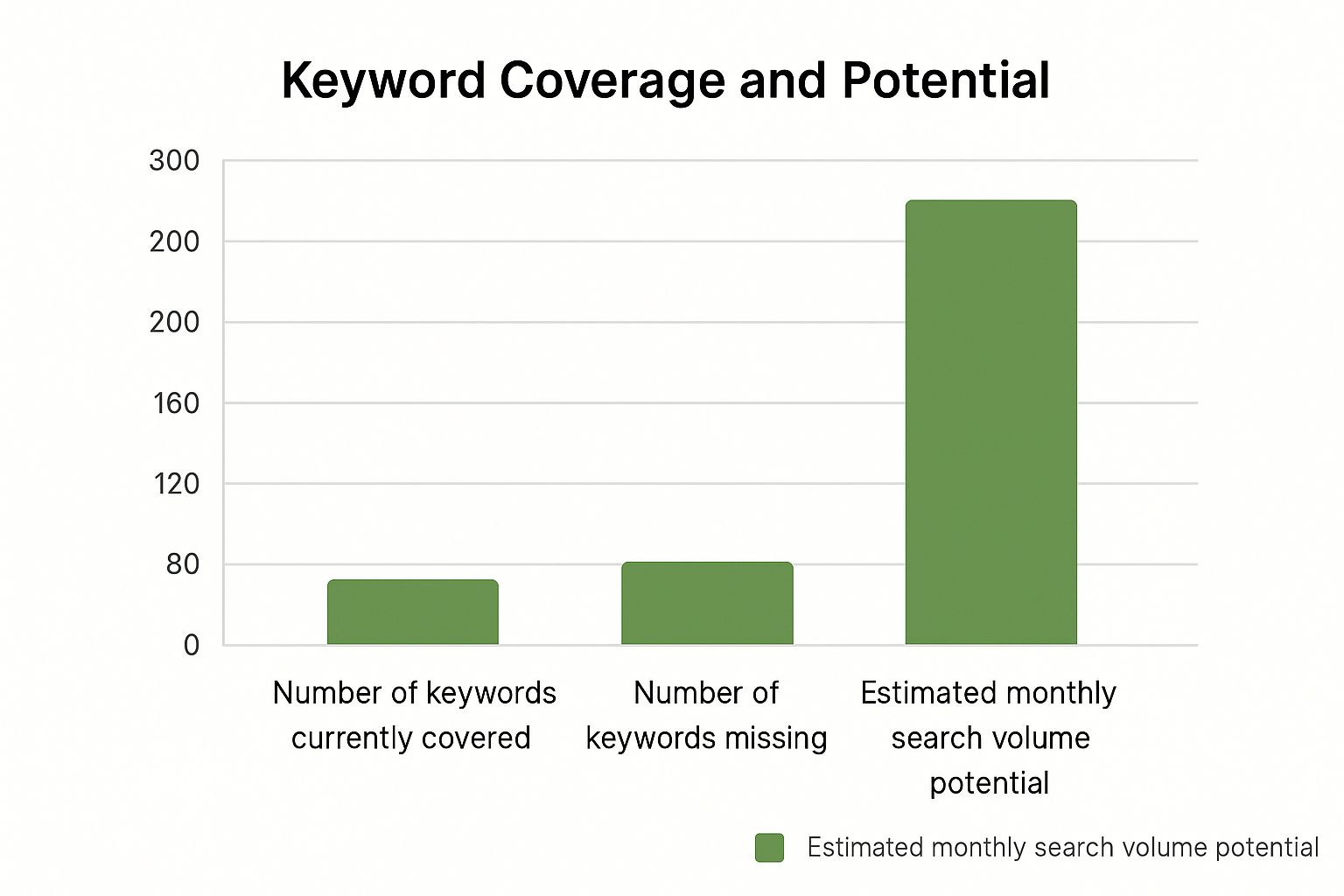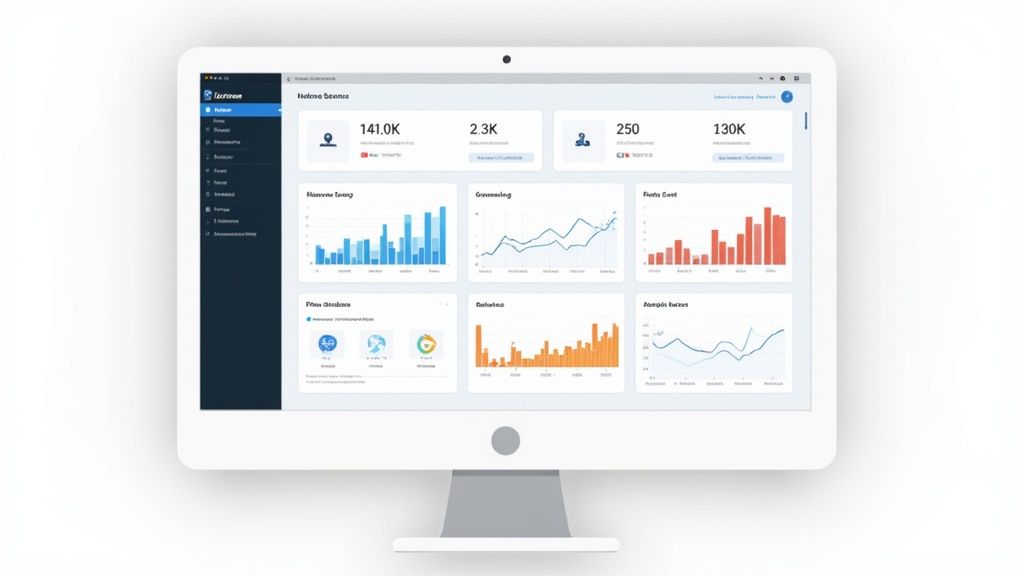Content Gap Analysis: Unlock Hidden Opportunities Quickly
Understanding Content Gap Analysis That Actually Works
Let's be real, "content gap analysis" sounds like another piece of marketing jargon to add to the pile. But what does it actually mean for your day-to-day work? Think of it less as a task and more as a shift in how you see your content strategy. While basic keyword research tells you what people are searching for, a content gap analysis shows you all the conversations your brand is missing out on.
More importantly, it pinpoints the exact topics where your competitors are swooping in and capturing your audience's attention. It's the difference between throwing content at a wall to see what sticks and strategically building a library of resources that your audience is actively looking for but can't find from you.
The Real Goal: Finding Unanswered Questions
Picture yourself as a content detective. Your main mission is to uncover the specific questions your audience is asking that you—and maybe even your competitors—have completely overlooked. These aren't just keyword gaps; they are opportunity gaps. It’s not enough to find a keyword your competitor ranks for that you don't. The magic happens when you dig into the intent behind those searches.
For example, a competitor might rank for the broad term "social media scheduling." But a closer look might reveal that the top-performing articles are answering a much more specific question: "How do I schedule Instagram Reels without losing quality?" That specific, unanswered question is your golden ticket. This kind of deep dive is a key part of developing a content marketing strategy that delivers real results.
Why Throwing More Content at the Wall Fails
It’s a common trap: the belief that publishing more content is the secret to success. But without a clear purpose, you're just adding to the noise and burning through your budget. You could churn out five blog posts a week, but if they aren't filling a specific need, they won’t make a dent in your goals.
A proper content gap analysis is the methodical process of spotting these missing topics or formats between what your audience wants and what you currently offer. You can learn more about why this has become so important on Upskillist.com.
Let's break down how this approach differs from the keyword research you might be used to.
| Approach | Traditional Keyword Research | Content Gap Analysis |
|---|---|---|
| Focus | Identifies popular search terms and volume. | Identifies topics and user questions your content doesn't address but competitors might. |
| Data Sources | Keyword planners, search volume tools. | Competitor analysis tools, audience surveys, customer feedback, SERP analysis. |
| Outcome | A list of keywords to target. | A strategic content plan focused on specific user needs and competitive opportunities. |
| Time Investment | Relatively quick, focused on data collection. | More in-depth, requires analysis of intent, competitors, and audience pain points. |
Comparison showing the key differences between basic keyword research and comprehensive content gap analysis approaches
As the table shows, a content gap analysis goes much deeper. It ensures every article, video, or social post you create serves a distinct purpose. It’s built to solve a problem, which helps you build authority and earn your audience's trust. You stop guessing what might work and start making informed decisions that create content that doesn't just attract visitors, but turns them into a loyal community.
Building Your Content Gap Analysis Foundation
Before you even think about firing up tools and building spreadsheets, a strong content gap analysis needs a solid foundation. This isn't about chasing vanity metrics; it’s about setting clear goals that tie directly to what your business wants to achieve. Think less about "more traffic" and more about attracting the right visitors who are genuinely looking for what you offer. Without this initial setup, your analysis can quickly become a data-gathering project with no real purpose.
Identifying Your True Competitors
First things first, you need to figure out who you’re really competing against. Your true competitors aren't always the big, obvious brands in your industry. They are any site, blog, or creator that ranks for the keywords and answers the questions your ideal audience is asking.
For instance, a social media scheduling tool like Publora might see other schedulers as its direct competitors. But its content competitors could be a much broader group:
- Marketing blogs that publish in-depth guides on social strategy.
- Creators who make video tutorials about content creation.
- Industry news sites that report on social media algorithm updates.
Pinpointing these different players is essential. It broadens your view beyond a simple product-vs-product comparison and shows you the full picture of where your audience spends their time and who they see as a trusted source. This deeper insight is a fundamental part of any effective content strategy framework.
Categorizing Opportunities That Matter
Once you know who you're up against, you need a way to sort through the potential content gaps. Not every gap is a golden opportunity; some are just rabbit holes that will eat up your time and budget. Smart strategists categorize opportunities to focus only on what's truly valuable. This means looking beyond basic keyword gaps and thinking about the different types of content you might be missing.
SEO tools are great for visualizing these opportunities. Take the Content Gap tool from Ahrefs, for example. It lets you pop in your domain next to a few competitors and instantly see which keywords they rank for that you don't.

This screenshot shows exactly how a tool can spotlight keywords where one or more of your rivals are in the top 10, but your site is nowhere to be found. This gives you an immediate, actionable list of topics to explore. By laying this foundational groundwork first, your analysis will be focused, efficient, and much more likely to generate content that delivers real results.
Choosing Tools That Match Your Needs And Budget

Diving into a content gap analysis without the right setup is like trying to build furniture without instructions—you might end up with something, but it probably won't be what you had in mind. The great news is you don't need the priciest subscription to uncover powerful insights. The trick is to build a smart toolkit that pulls from different sources to give you the full story.
The Paid Powerhouses
Let's start with the heavy hitters: Ahrefs and Semrush. These platforms are considered industry-standard for good reason. Their main advantage is their huge keyword and competitor databases, which are essential for this kind of work.
- Ahrefs' Content Gap tool is fantastic for quickly finding keywords your competitors rank for, but you don’t. It’s incredibly direct and serves up an immediate, actionable list of topics to target.
- Semrush’s Keyword Gap tool does something similar but really shines in its ability to compare up to five domains at once. This is perfect for getting a wider view of the competitive scene and understanding keyword overlaps and unique opportunities.
These tools are definitely an investment. However, if you're serious about your content strategy, the time they save and the quality of data they deliver often make the cost worthwhile.
Smart and Scrappy: Free Alternatives
You can pull off a surprisingly thorough content gap analysis without spending a penny. It just requires a bit of creativity and piecing together a few free resources.
Your first stop should be Google Search Console. The "Queries" report is an absolute goldmine. Filter for terms where you have a lot of impressions but very few clicks. This is a huge clue that Google thinks you're relevant, but your title or content isn't grabbing attention—a classic content gap.
Next, fire up a tool like AnswerThePublic to see the questions people are actually asking about your core topics. I like to combine this with some old-fashioned browsing on forums like Reddit or Quora. These platforms are where your audience talks about their problems in their own words, revealing pain points that a standard keyword tool might miss.
As you choose tools for your analysis, it's also smart to think about the next steps. For example, considering some of the top document automation software could help you streamline content creation once you have your new ideas. Ultimately, the best strategy often blends paid tools for big-picture data with free resources for that vital human touch, ensuring your analysis is both data-backed and genuinely focused on your audience.
Running Your Analysis Like A Seasoned Pro
Alright, this is where the magic happens and where you can really pull ahead of the competition. A top-notch content gap analysis isn't just about collecting a mountain of data. It’s about methodically sifting through it to spot those golden opportunities that everyone else has overlooked. Let's move beyond aimlessly scrolling through keyword lists and adopt a pro-level process that's focused and effective.
Uncovering Hidden Competitor Insights
Your first task is to put on your detective hat and dig into your competitors' content. But we're not just looking at what keywords they rank for. We need to analyze the types of content that are working for them. Are their highest-performing pieces in-depth guides, short video tutorials, or maybe side-by-side comparison articles? This reveals more than just popular topics; it shows you how your shared audience prefers to get their information.
For instance, imagine you see a competitor cleaning up in search results with a series of quick "how-to" videos. If you're only covering those same topics in long, text-heavy blog posts, you've just discovered a major media format gap. This kind of insight is pure gold because it points directly to an unmet user preference you can satisfy.
Balancing Opportunity with Practicality
Once you've compiled a list of potential content gaps—whether they're topics, keywords, or formats—it's time to get strategic. Not every gap is a green light. A classic rookie mistake is to chase high-volume keywords dominated by major players. That's often a slow, costly, and frustrating battle to fight.
Instead, let's vet each opportunity by asking two critical questions:
- How tough will it be to rank? Check out the authority of the websites on page one. Are you up against industry giants, or are they smaller blogs similar to yours?
- What's the potential business impact? Does this topic directly relate to a product you offer or a problem your service solves? A keyword with lower search volume but high purchase intent can be far more valuable.
To make this process more concrete, you can use a simple framework to score and prioritize your findings. A prioritization matrix helps you weigh factors like search volume against the actual business value, so you can focus your efforts where they'll count the most.
Here's an example of what that could look like:
Content Gap Prioritization Matrix
Framework for evaluating and prioritizing content gaps based on difficulty, opportunity, and strategic alignment.
| Gap Type | Search Volume | Competition Level | Business Impact | Priority Score |
|---|---|---|---|---|
| "How to choose" guide | 1,200/mo | Low | High | 9/10 |
| Product comparison | 800/mo | Medium | High | 8/10 |
| Video tutorial series | 500/mo | Low | Medium | 7/10 |
| Infographic | 250/mo | Low | Low | 4/10 |
| General industry news | 5,000/mo | High | Low | 3/10 |
This matrix clearly shows that while "general industry news" has the highest volume, the "how to choose" guide is the real winner because it's easier to rank for and has a much greater impact on the business.
This handy infographic shows just how much potential is often left on the table.

The chart makes it obvious: the untapped search volume from keywords you're missing can easily overshadow what your brand currently owns. When you think globally, these gaps become even more massive. With 2.57 billion people still not online, primarily in places like Southern Asia, there are huge opportunities to create content for new digital audiences. You can dive deeper into these trends in the latest global digital reports.
By systematically finding and prioritizing these content gaps, you're not just creating more content—you're building a focused action plan that targets the most impactful opportunities first, setting yourself up for real, measurable growth.
Transforming Analysis Into Content That Converts

Running a content gap analysis is one thing, but turning that spreadsheet of keywords and competitor data into content that actually performs is where most strategies fall flat. Raw data is just expensive research until you translate it into an actionable plan. This is the moment you shift from analyst to strategist, prioritizing opportunities that align with your real-world resources and business goals.
The biggest mistake I see marketers make is trying to fill every single gap they find. A much better approach is to use a prioritization framework to decide what to tackle first. An Effort-Impact matrix is a fantastic tool for this. It helps you sort your ideas into four simple quadrants:
- Low Effort, High Impact: These are your quick wins. Think about refreshing an old blog post with new keywords or turning a popular guide into a simple infographic.
- High Effort, High Impact: These are bigger projects, like creating a new video series or an in-depth guide on a major topic gap. They require more resources but promise significant returns.
- Low Effort, Low Impact: These are small but necessary tasks like fixing typos or adding alt text. They’re worth doing, but they shouldn't jump to the top of your to-do list.
- High Effort, Low Impact: These are the ideas you should probably shelve for now. They demand a lot of work for very little potential gain.
Creating High-Impact Content Briefs
Once you’ve cherry-picked your best opportunities, the next step is to build out detailed content briefs. A solid brief is the bridge between your analysis and your creative team, ensuring everyone understands the exact gap you’re trying to fill. It needs to go way beyond just a topic and a primary keyword.
Let’s say your analysis uncovers a gap around “Instagram Reels scheduling for small businesses.” A weak brief would just list that as the topic. A strong brief, however, would include:
- Specific Questions to Answer: What are the common pain points? (e.g., losing video quality, posting at the wrong time).
- Target Audience: Small business owners who are short on time and likely not social media experts.
- Media Format: A blog post with embedded video tutorials and a downloadable checklist.
- Competitor Angles to Beat: Note what the top-ranking articles miss, like specific tips for different industries or budget-friendly tool recommendations.
This level of detail turns your content gap analysis from a research document into a precise set of instructions for creating content that connects and converts. It's a key part of building an effective content creation workflow that delivers results you can actually measure.
Measuring Success And Avoiding Costly Mistakes
You’ve done the hard work, run your analysis, and now you have a promising list of content gaps to fill. But this is where even the most well-researched content gap analysis can fall apart. Publishing new content without a clear way to measure its success is like setting off on a road trip with no map—you're definitely moving, but you have no idea if you're getting any closer to your destination. Success here isn’t just a quick spike in traffic; it's about connecting your content directly to real business growth.
Metrics That Actually Matter
Let's push vanity metrics aside for a moment. Sure, more pageviews are nice to see, but they don't directly pay the bills. Instead, we need to focus on metrics that reveal how users are behaving and how that behavior impacts your bottom line. When you create content to fill a specific gap, you have to track whether it's actually doing the job you designed it for.
The secret is to link your content's performance to its place in the customer journey. For example, if you publish a bottom-of-funnel comparison guide, the most important metric isn't traffic; it's the conversion rate on that page. Are people who read it signing up for a trial or scheduling a demo? If not, the content isn't hitting the mark, regardless of how many people see it. When we discuss measuring success, we're really focusing on a specific set of content marketing metrics that dig deeper than surface-level numbers.
Here are a few metrics you should prioritize:
- Keyword Ranking Improvement: Are you moving up in the search results for the specific gap-related keywords you targeted? This is your first signal that your strategy is on the right track.
- Engagement Rate: Keep an eye on metrics like time on page and scroll depth. If people are sticking around to read your entire in-depth guide, it shows you’ve successfully met their search intent.
- Lead Generation: For content linked to your products or services, track how many new leads or trial sign-ups come directly from that article. This is your direct line to ROI.
- Improved User Pathways: Use tools like Google Analytics to see if your new content is successfully guiding visitors to other key pages on your site, like your product or pricing pages.
Knowing When to Walk Away
One of the toughest lessons in content strategy is learning which gaps are better left alone. Just because a competitor is ranking for a particular keyword doesn't mean you have to chase it. Some topics, even with high search volume, attract an audience with absolutely zero interest in buying anything. Pursuing these is a classic and costly mistake.
For instance, a high-volume keyword like "free social media templates" might look tempting on the surface. But the people searching for it are looking for freebies, which makes them very unlikely to become paying customers for a tool like Publora. It’s a much better use of your resources to focus on a lower-volume, high-intent keyword like "best scheduler for Instagram Reels quality." This term targets a specific problem that your product solves, attracting visitors who are much closer to making a purchase.
A successful content gap analysis isn’t just about finding what’s missing; it's about having the discipline to pursue only the gaps that truly matter to your business.
Creating Systems for Ongoing Success
The biggest mistake you can make with a content gap analysis is seeing it as a one-and-done project. That first rush of finding new opportunities is a great feeling, but the real win comes from weaving this analysis into a continuous, manageable process. You need a system that keeps your content strategy nimble and ahead of the curve without eating up all your time. This is about making gap analysis a regular habit for your team, not a dreaded quarterly chore.
Making Gap Analysis an Ongoing Habit
The idea is to get your team to spot content gaps naturally, even when they're just going about their daily tasks. Think about all the places you're already collecting audience insights. For example, your social media manager is on the front lines, seeing questions in comments and DMs every day—these are raw, unfiltered content gaps just waiting to be filled. The same goes for your customer support team, who handle questions about product features or best practices all day long.
Here’s how you can make this systematic:
- Create a Centralized Idea Hub: Set up a shared space where anyone can easily drop potential content gaps they stumble upon. This could be a dedicated Slack channel, a Trello board, or a simple shared spreadsheet. It could hold anything from a screenshot of a competitor's ad to a recurring customer question or a trending topic discovered on Reddit.
- Schedule Quarterly Reviews: Don't let a whole year pass before you reassess. Set aside time each quarter to formally go through your idea hub, run a fresh competitor analysis, and check how your recently published content is performing against the gaps you aimed to fill. A 90-day cycle is short enough to stay relevant but long enough to collect meaningful data.
Scaling Your Analysis as You Grow
As your business gets bigger, your method for finding content gaps has to grow with it. What works for a solo creator is not going to cut it for an expanding agency. The trick is to introduce some simple automation and more polished workflows. Instead of manually checking ten competitors every month, you could set up alerts in your SEO tool to ping you whenever a competitor starts ranking for a new keyword in the top 10.
Try structuring your content calendar around "themes" you've identified from your gap analysis for the quarter. For instance, if your research shows a major gap around "AI for social media," you can plan an entire series—blog posts, videos, and social updates—to truly own that topic. This strategy is much more effective than just tackling random, disconnected gaps as they pop up. By building these practices into your workflow, a content gap analysis shifts from a massive project into a sustainable engine for growth.
Ready to streamline your entire social media workflow? With Publora, you can plan, schedule, and publish content based on your findings, all from one dashboard. Start your free 14-day trial of Publora today and turn your insights into action.
